When your boss is an algorithm
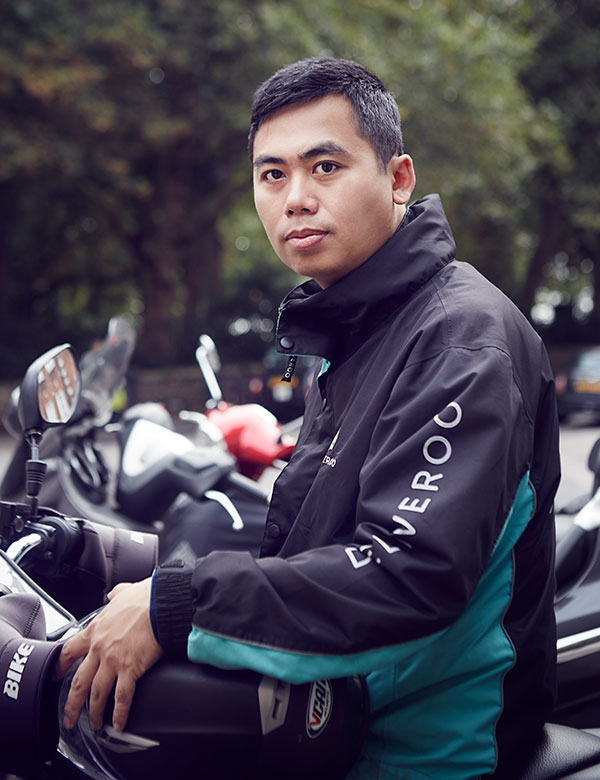
Simply sign up to the Life & Arts myFT Digest -- delivered directly to your inbox.
The small London side street reverberates with the growl of motorbikes and the shriek of horns. A young man yells hoarsely into a megaphone: “They’re gonna be disrupted, yeah! Because your lives are being disrupted, yeah! This is the money you need to live!” Dozens of men in T-shirts and jeans cheer and pump the horns on their motorbikes, scooters and bicycles. Many have pieces of A4 paper taped to their backs that say: “We are people, not Uber’s tools!”
This protest outside the UberEats office in south London on August 26 is one of the first industrial disputes to hit the city’s so-called gig economy. It is a strange clash. These are workers without a workplace, striking against a company that does not employ them. They are managed not by people but by an algorithm that communicates with them via their smartphones. And what they are rebelling against is an app update.
UberEats launched in London in June, promising “the food you want, from the London restaurants you love, delivered at Uber speed”. In a bid to recruit self-employed couriers to ferry food from restaurants to customers, UberEats initially offered to pay £20 an hour. But as customer demand increased, the company began to reduce pay. By August, the couriers were on a piece rate with a fiddly formula: £3.30 a delivery plus £1 a mile, minus a 25 per cent “Uber service fee”, plus a £5 “trip reward”. Then, one day, the couriers woke up to find the app had been updated again. The “trip reward” had been cut to £4 for weekday lunch and weekend dinner times, and to £3 for weekday dinner and weekend lunch times. Outside those periods, it had been cut altogether.
“They tricked us,” roars a man called Manou over the din, hunching over the handlebars of his motorbike. Like many experienced couriers, he left his job with a different delivery company because Uber was offering better pay. Not any more. “They make us feel like they can just use us and destroy us and create new tools,” he says. Imran Siddiqui, one of the leaders of the protest, says he feels bad because he had encouraged other couriers to sign up for UberEats before they changed the pay. “If they don’t resolve this strike it’s going to spread like a fire.”
It’s hard to spread the word when you don’t even know who your colleagues are. But the couriers have an idea. They open their apps as customers and order food to be delivered to them. As UberEats couriers arrive with pizzas at the place their app has sent them, the strikers tell them about the protest and urge them to join in. Algorithmic management, meet algorithmic rebellion.
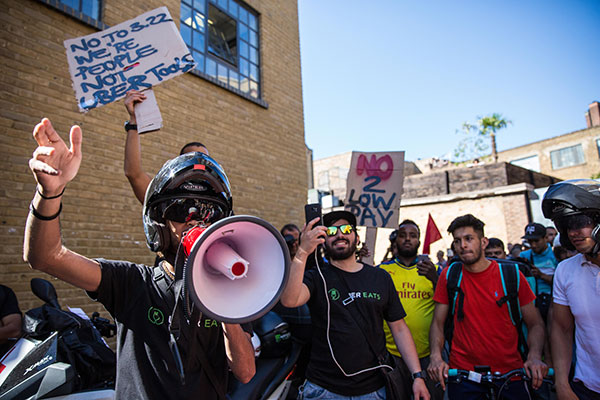
There are no good estimates on the global scale of the gig economy but in the US there are about 800,000 people earning money this way — via online intermediaries such as TaskRabbit, Lyft, Uber and Deliveroo — without being anyone’s employee. The term “algorithmic management” was coined last year by academics at the Carnegie Mellon University Human-Computer Interaction Institute, and it is this innovation, they argue, that makes the gig economy possible. For companies like Uber, which aspires to “make transportation as reliable as running water”, algorithmic management solves a problem: how to instruct, track and evaluate a crowd of casual workers you do not employ, so they deliver a responsive, seamless, standardised service.
Those deploying algorithmic management say it creates new employment opportunities, better and cheaper consumer services, transparency and fairness in parts of the labour market that are characterised by inefficiency, opacity and capricious human bosses. But a summer of wildcat strikes in London’s gig economy shows that some workers are beginning to chafe against the contradictions of being “their own boss” yet tightly managed by the smartphones in their pockets. They might be free to choose when to work but not how to work or, crucially, how much they are paid.
Bhone Kyaw has been standing around on the street for half an hour when his phone chirrups. It is a balmy Monday evening in London’s wealthy St John’s Wood and orders are finally flowing. Kyaw is one of 20,000 self-employed couriers who work for Deliveroo, a food-delivery company founded in London in 2013 by former investment banker Will Shu. Already in 84 cities across 12 countries, it has just raised $275m from investors to bring its total to almost half a billion dollars, making it one of Europe’s best-funded start-ups.
Kyaw, a boyish-looking 30-year-old, has been working for Deliveroo for about nine months. He works 40-50 hours a week over six days and makes £400-£450 before tax, motorbike insurance and maintenance. In most parts of London, Deliveroo schedules shifts, which couriers agree a week in advance. They must work at least two of Friday, Saturday and Sunday evenings (though Deliveroo says shifts can be moved around when necessary). They are paid £7 an hour plus £1 a delivery, tips and petrol.
Kyaw whips out his phone. The app expects him to respond to new orders within 30 seconds. The screen shows a map and address for the local Carluccio’s, an Italian restaurant chain. A swipe bar says “Accept delivery”. That is the only option. The algorithm will not tell him the delivery address until he has picked up the food from Carluccio’s. Deliveroo couriers are assigned fairly small geographic areas but Kyaw says sometimes the delivery address is way outside his allocated zone. You can only decline an order by phoning the driver support line. “They say, ‘No, you have to do it, you already collected the food.’ If you want to return the food to the restaurant they mark it as a driver refusal — that’s bad.”
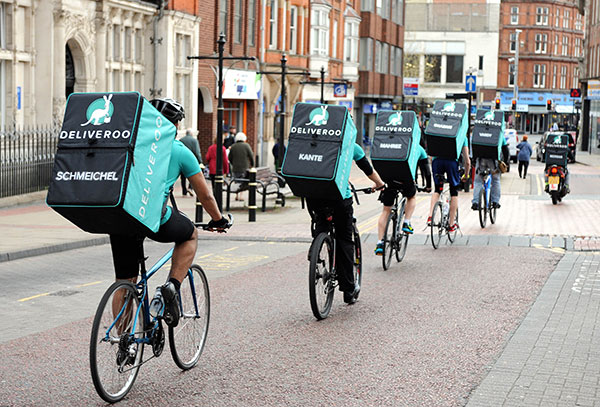
Bad how? Deliveroo’s algorithm monitors couriers closely and sends them personalised monthly “service level assessments” on their average “time to accept orders”, “travel time to restaurant”, “travel time to customer”, “time at customer”, “late orders” and “unassigned orders”. The algorithm compares each courier’s performance to its own estimate of how fast they should have been. An example from one of Kyaw’s assessments: “Your average time to customer was less than our estimate, which means you are meeting this service-level criterion. Your average difference was -3.1 minutes.” Deliveroo confirmed it performs the assessments but said its “time-related requirements” took into account reasonable delays and riders were “never against the clock for an order”.
Drivers for Uber’s ride-hailing app, of which there are about a million around the world, are subject to similar algorithmic control. They choose when to work but once they log on to the app, they only have 10-20 seconds to respond to “trip requests” routed to them by the algorithm. They are not told the customer’s final destination until they have picked them up. If drivers miss three trip requests in a row, they are logged out automatically for two minutes. Uber sends drivers a weekly report including their confirmation rate and average customer rating (out of 5).
Documents submitted as part of an employment tribunal case brought by the GMB union against Uber in London include an email sent to driver James Farrar in May congratulating him on an average rating above 4.4. “We will continue to monitor your rating every 50 trips and will email you if we see your rating for your past 50 trips falls below 4.6.” Uber will “deactivate” drivers whose ratings drop too low, though it says this is “extremely rare”. The court case documents include one instance, in which Uber sent an email on December 23 2013 to a driver called Ashley Da Gama: “Hi there, we would like to wish you a Merry Xmas and a Happy New Year. We are currently planning for 2014 and would like you to be part of it. However, we do need to see an improvement on your current track record to ensure you are.” Two weeks later, Uber emailed again to say his ratings had not improved enough. His account had been “deactivated . . . as of today”.
. . .
Algorithmic management” might sound like the future but it has uncanny echoes from the past. A hundred years ago, a new theory called “scientific management” swept through the factories of America. It was the brainchild of Frederick W Taylor, the son of a well-to-do Philadelphia family who dropped his preparations for Harvard to become an apprentice in a hydraulics factory. He saw a haphazard workplace where men worked as slowly as they could get away with while their bosses paid them as little as possible. Taylor wanted to replace this “rule of thumb” approach with “the establishment of many rules, laws and formulae which replace the judgment of the individual workman”. To that end, he sent managers with stopwatches and notebooks on to the shop floor. They observed, timed and recorded every stage of every job, and determined the most efficient way that each one should be done. “Perhaps the most prominent single element in modern scientific management is the task idea,” Taylor wrote in his 1911 book The Principles of Scientific Management. “This task specifies not only what is to be done but how it is to be done and the exact time allowed for doing it.”
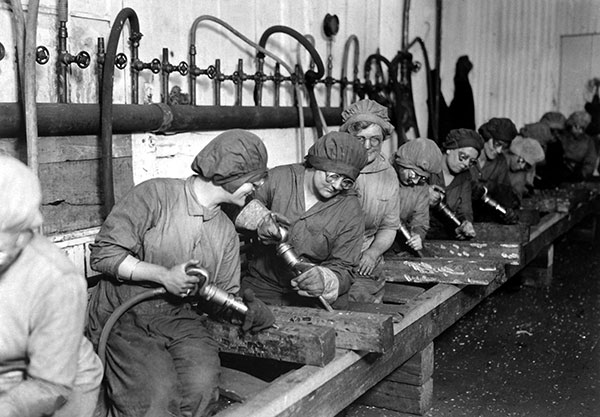
Taylor tested many of his ideas on the 600 or so labourers who worked in the yard of the Bethlehem Steel Company. After a series of experiments, he decided that a “first class” shoveller would be most productive if he lifted 21 pounds of weight with every shovel load. He ordered different-sized shovels for each type of material in the yard: a small shovel to hold 21 pounds of ore; a large one to hold 21 pounds of ash. The men went to a pigeonhole each morning where a piece of paper would tell them which tools to select and where to start work. Another piece of paper would tell them how well they had performed the previous day.
“Many of these men were foreigners and unable to read and write but they all knew at a glance the essence of his report, because yellow paper showed the man that he had failed to do his full task the day before, and informed him that he had not earned as much as $1.85 a day, and that none but high-priced men would be allowed to stay permanently with this gang,” Taylor explained.
Taylor advocated his new theory with evangelical zeal. Charles Harrah, one-time owner of the Midvale Steel Company, where Taylor pioneered many of his ideas, once told him: “Do you know what I am going to do when I have made a few more millions? I am going to build the finest insane asylum this world has ever known, and you, Taylor, are going to have there an entire floor.”
Nonetheless, scientific management took off, improving productivity in the vast factories of early 20th-century America. It was the logical precursor to Henry Ford’s production lines. And its legacy can be seen in factories, call centres and warehouses today, although new technology has taken the place of Taylor’s instruction cards and stopwatches. Many warehouse workers for companies such as Amazon use handheld devices that give them step-by-step instructions on where to walk and what to pick from the shelves when they get there, all the while measuring their “pick rate” in real time. For Jeremias Prassl, a law professor at Oxford university, the algorithmic management techniques of Uber and Deliveroo are Taylorism 2.0. “Algorithms are providing a degree of control and oversight that even the most hardened Taylorists could never have dreamt of,” he says.
The next frontier for algorithmic management is the traditional service sector, tackling retailers and restaurants. “Taylor’s ideas have been applied very widely in manufacturing . . . but the services industry has always been a black box,” says Serguei Netessine, professor of global technology at Insead business school. “It has been very difficult to figure out: is it employees who are performing well? Or is the employee getting lucky? Now with data we can do this.” So Frederick Taylor is heading to the high street? “Yes — Taylor on steroids.”
Percolata is one of the Silicon Valley companies trying to make this happen. The technology business, which Netessine advises, has about 40 retail chains as clients, including Uniqlo and 7-Eleven. It installs sensors in shops that measure the volume and type of customers flowing in and out, combines that with data on the amount of sales per employee, and calculates what it describes as the “true productivity” of a shop worker: a measure it calls “shopper yield”, or sales divided by traffic.
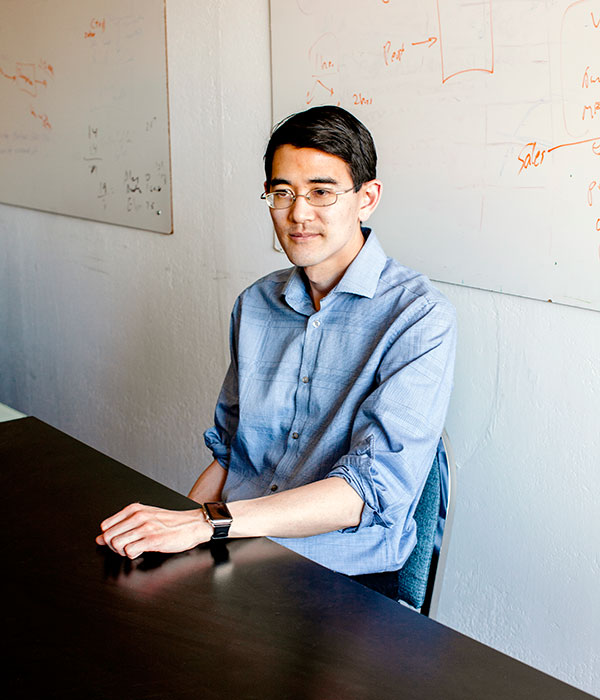
Percolata provides management with a list of employees ranked from lowest to highest by shopper yield. Its algorithm builds profiles on each employee — when do they perform well? When do they perform badly? It learns whether some people do better when paired with certain colleagues, and worse when paired with others. It uses weather, online traffic and other signals to forecast customer footfall in advance. Then it creates a schedule with the optimal mix of workers to maximise sales for every 15-minute slot of the day. Managers press a button and the schedule publishes to employees’ personal smartphones. People with the highest shopper yields are usually given more hours. Some store managers print out the leaderboard and post it in the break room. “It creates this competitive spirit — if I want more hours, I need to step it up a bit,” explains Greg Tanaka, Percolata’s 42-year-old founder.
The company runs “twin study” tests where it takes two very similar stores and only implements the system in one of them. The data so far suggest the algorithm can boost sales by 10-30 per cent, Tanaka says. “What’s ironic is we’re not automating the sales associates’ jobs per se, but we’re automating the manager’s job, and [our algorithm] can actually do it better than them.”
Better for the employer? Or better for the workers? Both, argue Tanaka and Netessine. Unlike human store managers, algorithms do not use hours to reward the people they like, or the people they are related to, or the people who look like them. Tanaka is forever fighting battles against the “incredible biases” of managers who want to tweak his algorithm’s carefully calibrated schedules. “The manager comes in and says, ‘Look, my favourite person is not working when I’m working, so I want to muck with the schedule’ and it’s like, ‘Oh my god, just by doing that you lost a few percentage points in sales!’”
Tanaka says his algorithm is also a more reliable boss because it is better at forecasting demand: employees tell the app when they are available to work, then receive their schedules in advance. They are not subject to the chaotic scheduling common in many retail jobs, where employees are sometimes sent home early because the shop is unexpectedly quiet, or told to wait by the phone. Kayley Hignell, head of policy at the UK’s Citizens’ Advice Bureau, a charity, says technology that gave employees more visibility on their rotas and pay would be welcome. Many people have no idea how shambolic some jobs are at the bottom of the labour market, she says: rotas pinned on noticeboards that you have to check on your day off; incomplete payslips that haven’t recorded the right hours. “It’s good to see movement in the direction of utilising tech to help out with those challenges,” she says. But she warns against taking it too far. “Having a good line manager makes people feel more secure . . . you can’t tell a computer that your childcare arrangements are up in the air at the moment.”
Not everyone buys the idea that algorithms will treat people fairly. “You can’t take that seriously,” says Guy Standing, a professor of development studies at the School of Oriental and African Studies, University of London, who writes about precarious work. “The same rule applied to everybody might turn out to be more inequitable than subtle human judgment.”
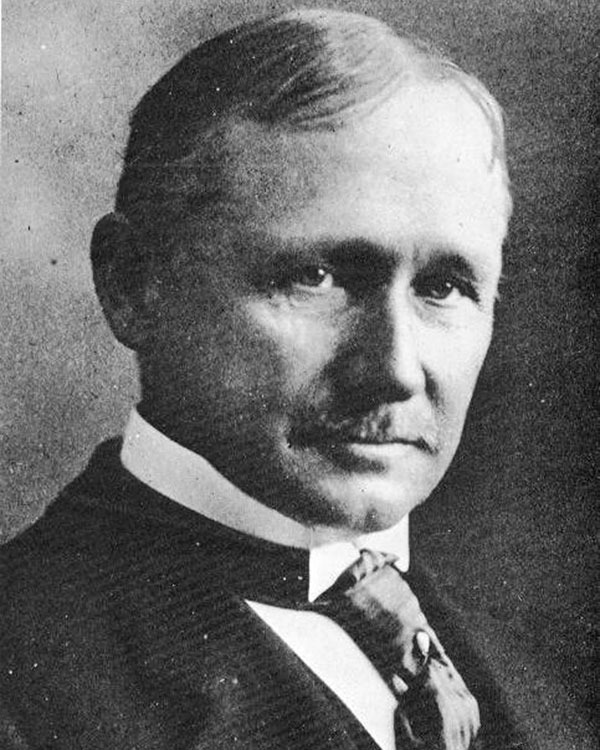
While Percolata can predict demand and schedule workers up to a month in advance, Tanaka believes that retail jobs will eventually become so flexible in response to fluctuating demand that they become part of the gig economy. Wouldn’t it be better to just pay people more for the time they are actually productive, he asks? “That’s what Uber does; they don’t pay people for sitting in the car when there’s no one in the car.”
. . .
Deliveroo has just decided to try the same approach. This summer it started to trial a new system in a few London zones, where couriers are not scheduled in advance but can log in to work whenever they want. The quid pro quo is that they will only be paid a piece rate of £3.75 a delivery. They gain flexibility but shoulder the financial risk — borne previously by the company — that they will wait around unpaid when demand is slow.
That is fine for people such as Anja Bosio, a 21-year-old student, who rides for Deliveroo because she loves to cycle, and usually only at busy times. She used to work as a waitress but she prefers to be out on her own, where the only demands come from the algorithm on her phone. “With waitressing I was always looking over my shoulder; this is a lot less stressful.”
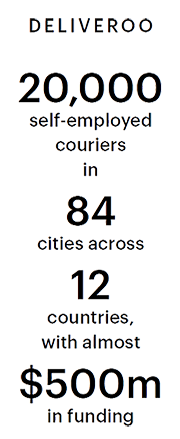
But the new piece-rate system has panicked couriers such as Bhone Kyaw, for whom Deliveroo is a full-time job. He and his partner have a five- and a four-year-old; she works for Deliveroo too but only on weekends when her mother can look after the kids. “There is no way we can survive on £3.75,” he says. He joined a wildcat strike of Deliveroo drivers in August that — with the help of the Independent Workers’ Union of Great Britain — won some concessions from management: guaranteed deliveries per hour during peak times for the period of the trial, and a promise that those who did not want to take part could move to a different zone.
But Kyaw fears that Deliveroo will impose the new system as planned after the trial ends in mid-September. Earlier that morning, he had worked for three hours and received five jobs. Under the old system he would be paid £26; under the new one, £18.75. “They will say, ‘Why are you guys waiting at a time when it’s not busy? But people want to make money because they have a family, and even at the busy time we can’t guarantee how many deliveries we’ll make.”
A few months ago, he was knocked off his motorbike and had to pay for the repairs because his third-party insurance did not cover the incident. He hurt his knees and elbows and couldn’t work for a week. “We need at least a safety net for our earnings to do the bike maintenance, to pay for the insurance, to pay for our rent, our bills.”
Is the problem that couriers like Kyaw are trying to use Deliveroo as a full-time job when it is simply not designed for that purpose? No, he insists. Deliveroo treated him like an employee when it suited them. Like when he came down with flu this March and emailed to say he wouldn’t be able to do his shifts. Deliveroo sent him this email: “Due to your unavailability without any communication I have decided to terminate your services agreement with Deliveroo . . . We will not return your deposit and process your final fees until you have worked your notice period, returned your equipment and shown that you have removed all Deliveroo stickers from your delivery box.”
When Kyaw sent screenshots to prove he had told them he was sick, they reinstated him. Still, he says, “They are treating you like an employee, so how can they say it’s self-employment?” He feels as if Deliveroo has all the power of an employer but none of the responsibility.
. . .
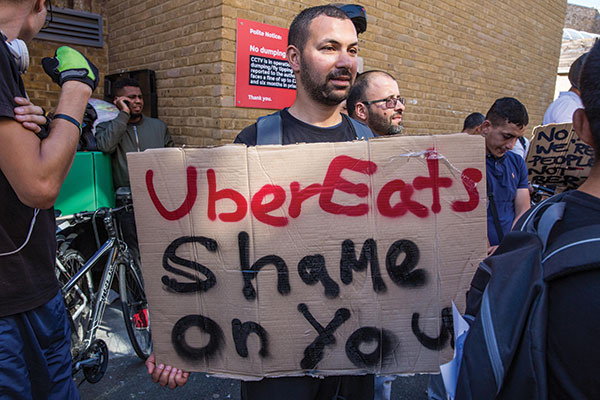
Some gig-economy workers and unions are bringing this question to court. They argue that these companies’ algorithms exert so much control over workers that they are really employees in the eyes of the law and thus owed hourly minimum wages, sick pay, holiday pay and the like. This is the kernel of the argument the law firm Leigh Day made on behalf of the GMB union against Uber, which was heard in a London employment tribunal earlier this summer. James Farrar, an Uber driver who was one of the claimants in that case, submitted a long witness statement detailing all the ways in which he said the algorithm controlled him. He was subject to 10-minute log-offs for cancelling too many rides (a process Uber says it has now updated), which presented him with a choice between “a 10-minute sin-bin when I cannot work or earn, and carrying out a trip which is uneconomical or risky for me”. If he worked for himself and Uber’s only function was to connect him with passengers, he argued, he would be able to do “just the journeys I want to do and that I judge are safe”. Uber’s defence was simple: drivers can’t be deemed employees because they have no obligation at all to log on to the app.
The tribunal’s ruling is expected in October. Martin Warren, a partner and head of labour relations at the Eversheds law firm, says the gig economy poses a profound challenge to the way the law defines jobs. Many gig workers simply do not fit neatly under an employee or a self-employed label. “Is it going to lead to a redefinition of the employment/self-employment divide with a broader test for employment? That is the question to pose.”
Policymakers, meanwhile, are flummoxed. Robert Rubin, former US Treasury secretary, summed up their dilemma at a recent Hamilton Project think-tank discussion on the gig economy. “The question is how to protect workers while at the same time garnering and reaping the benefits of change and innovation.”

Gig-economy companies provide undoubtedly popular services to consumers, and many workers clearly value the flexibility to work when they want. Make us treat workers as traditional employees, the companies say, and all that will go away.
An Uber representative told the FT that both “private hire drivers and couriers partnering with Uber do so with complete flexibility and are able to choose when and where they log in. Uber does not set shifts or allocate zones for its couriers or partner-drivers to operate in. Over 30,000 people have partnered with Uber in London so they can be their own bosses and make money on their own terms.” He said UberEats had offered pay incentives in the early days while it built demand for the service, and was now reducing them because couriers were making more deliveries, so were earning more at peak times.
A Deliveroo official said: “All of our riders work with us flexibly, often around other commitments, such as studying, family or additional work commitments.” Some 85 per cent of couriers have told Deliveroo they use it for “a supplementary income, or short-term flexible work”. She also said that previous trials of the piece-rate system found that couriers’ earnings were up to 2.1 times higher at the busiest times, with “our most efficient riders” making £15-£18 an hour. She added that safety was Deliveroo’s “top priority”.
Yet for critics such as Guy Standing, one man’s flexibility is another man’s insecurity. The gig economy is fuelling a “precariat” class of workers denied the protections of traditional jobs, he says. Algorithms provide “fantastic opportunities for rapacious exploitation” of people who are already at the bottom of the labour market. “They can monitor and make sure they only pay for the time they really want to pay for, and yet have people available at all times, waiting on call.”
We were having these same arguments 100 years ago. Taylor’s “scientific management” triggered a swift backlash from unions and workers, resulting in a special congressional investigation in 1911. Trade unionists, factory workers and Taylor himself were summoned to Congress to testify about this strange new system.
James O’Connell, the president of the International Association of Machinists, used his appearance to condemn the “lead-pencil faddists” who were deskilling work and dehumanising workers. Edward Vreeland, a Republican congressman, asked him whether piecework was not the fairest way to pay. “No,” he snapped. “Under no circumstances. The boss sets the price, the speeder sets the pace, the strong, stout, energetic young man sets the standard of life for his older brothers. That is piecework. The organisation of men has been driven out in every way, and the men are helpless.”
He declared to the assembled congressmen: “The labouring men of this country will not permit the Taylor system to be introduced in the factories in this country.”
Taylor could not have predicted the rise and fall of America’s trade unions over the rest of that century. But, like many of today’s gig-economy companies, he was quietly confident that his ideas would win out in the end. Like Uber and Deliveroo, he had faith in the power of his system to provide consumers with cheaper and better stuff, and believed that would ultimately overwhelm all objections. “At first glance we see only two parties to the transaction, the workmen and their employers,” he wrote in his book. “We overlook the third great party, the whole people — the consumers who buy the product of the first two.”
“In the end,” he predicted, “the people . . . will force the new order of things on both employer and employee.”
Sarah O’Connor is the FT’s employment correspondent
Photographs: Fred MacGregor; Mark Kerrison / Alamy Stock Photo; Press Association; Everett Collection Historical / Alamy; Carlos Chavarría
Comments